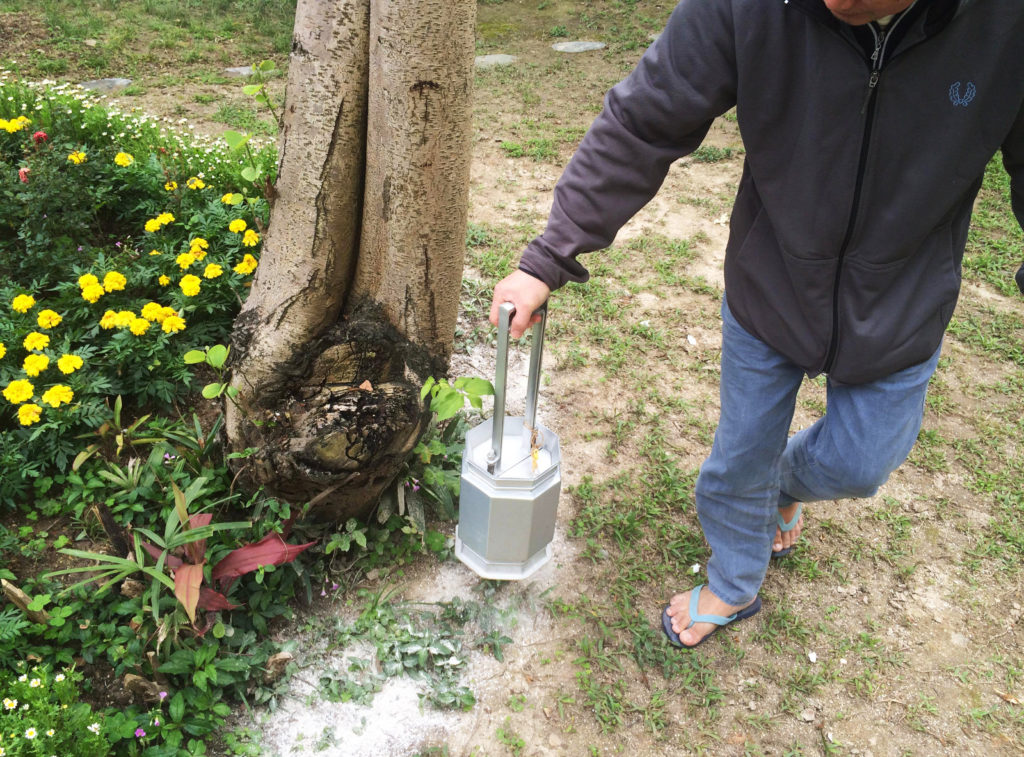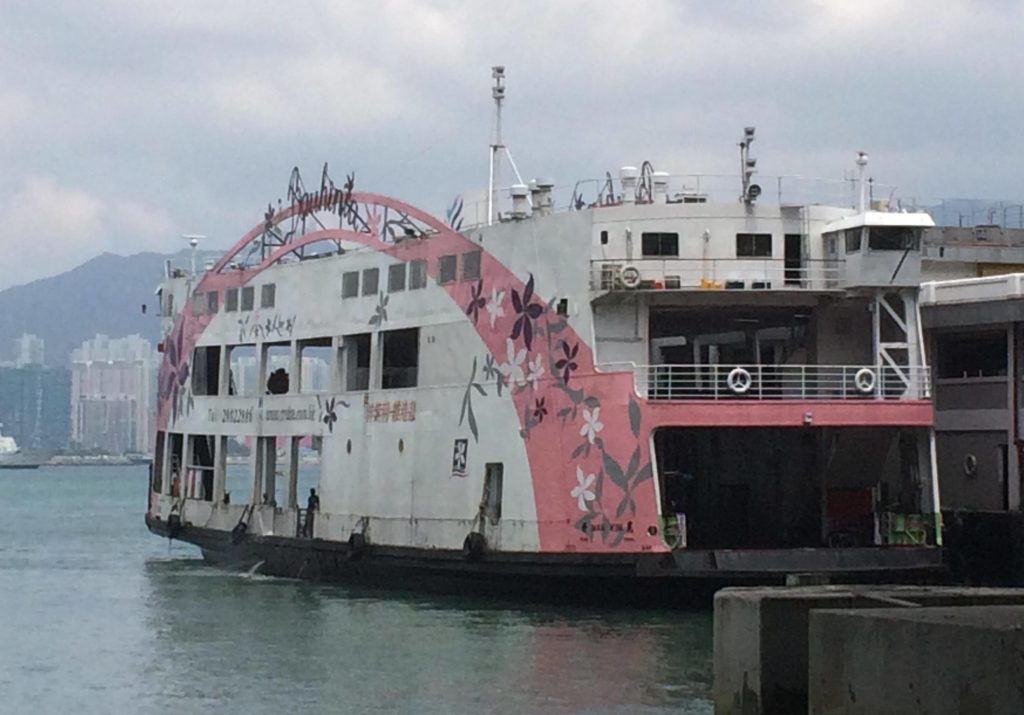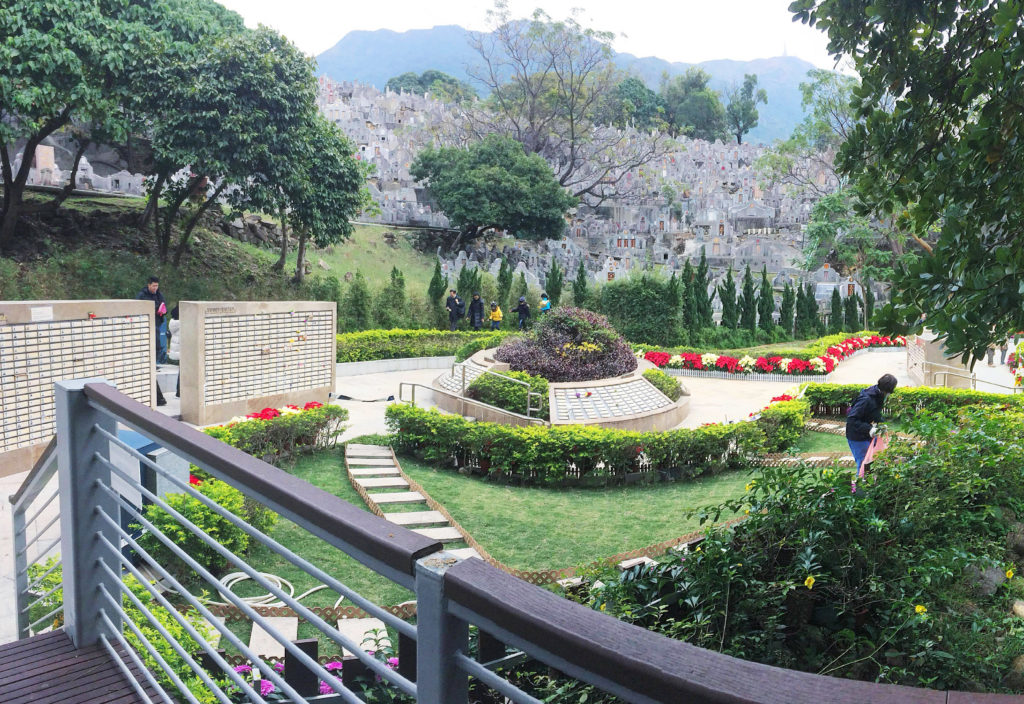In the Fu Shan Garden of Remembrance, Heaven Kam attended two of the shortest funerals he has ever been to.
Within 15 minutes, the priests said their prayers, and family members, with tears in their eyes, scattered the cremated ashes on the grass, whispering their last goodbyes as they walked slowly down the garden path.
“They wanted to keep the burial simple,” said Kam of the ceremonies, which were for his mother and sister. “Turning into ashes, gone with wind.”
In Hong Kong, funeral services like these — known as “green burials” — are not typical.
Overwhelmingly, Hongkongers keep the remains of their loved ones in ceramic urns placed in columbarium niches, spaces about the size of a desk draw.
The city, however, has renewed its push for residents to consider scattering their deceased’s cremated ashes — either in memorial gardens or at sea — amid an acute shortage of niches, exacerbated by its limited space and aging population.

Eleven memorial gardens have been built near traditional cemeteries, with stone walls for plaques to honor the dead. Ferries paid for by the government take mourners to scatter ashes out at sea every weekend.
Advertisements have been set around the city and a series of short films starring prominent figures like columnist Benny Li and former top official Raymond Young have been released to promote green burials.
But the efforts have struggled to gain traction, with less than 10 percent choosing “green burials” at a memorial garden or at sea, according to a 2015 government study, the most recent figures available.
Much of the reluctance is rooted in tradition and religious beliefs, though a lack of communication between children and parents about death is also hampering the uptake, according to some funeral service providers, who also say the government could do more to make the ceremonies more appealing.
For Kam, the decision was straightforward. Unlike in many cases, his loved ones expressly said they wanted a garden burial. His mother, he said, feared her grave would be forgotten as generations passed.
“She didn’t want to be an ‘orphan’ in cemetery,” Kam said with a sigh.
But despite their wishes, Kam said some in his family were dismayed with the decision to scatter his mother and sister’s ashes unlike the remains of his father, an immigrant from Guangdong province, who was put to rest in the traditional way.
He said children faced a lot of pressure to make annual visits to their parents graves in his hometown, where ancestor worship was prevalent.
“Elders in my family asked: why would you do that,” said Kam, adding he did not feel obliged strictly to follow tradition nor rituals of his Christian faith.
“Ceremonies are only done to be seen by others. I respect what my mother and sister wanted.”
But for many, expectations matter, even if they can sometimes be misguided, said Angel Lee, who works for Green Life Services Limited, which specializes in planning sea burials.

Lee said many elderly people have contacted the service and expressed interest in having their ashes scattered as not to be a burden on their descendants. In the absence of dialogue, however, their children chose a traditional funeral, she said.
“They’d rather talk to us, and ask us to persuade other family members [to hold a green burial],” she said, adding that as many as one in three of their clients faced resistance from their relatives about using the service.
“But many children still hold a sense of responsibility. They think spending over than HK$100,000 (US$12,800) on a niche slot proves their filial piety.”
According to government figures, the remains of nearly 100,000 people are on a waiting list for a niche at a public columbaria, which take an average take five years to become available and cost between HK$2,800-HK$21,000 (US$360-US$2,685) depending on size and location.
For years, the shortage has meant many families choose to use private columbaria, which can cost more than HK$100,000 per niche.
A new regulatory scheme adopted in June, however, has placed the future of many private operators in doubt.
As of Dec. 30, private columbaria began needing to apply for licenses and meeting strict standards.
The changes, predict industry experts, could result in closures that would see up to 300,000 urns held by private operators returned to their relatives, intensifying the shortage and further pushing up prices.
In a bid to persuade families to discuss the subject, the Enable Foundation, an NGO advocating for green burials has started offering tours of some of the city’s 11 memorial gardens.
The tours also visit the ships used to ferry mourners free-of-charge every Saturday to scatter ashes at one of three prescribed locations on the water.
Enable co-founder Yankee Lee urged children to try and talk openly with their parents about the subject.
“Hongkongers are too busy for heart-to-heart communication, so they tend to go for a ‘safe mode’ — purchasing a niche slot,” she said. “It’s not being filial. It’s just following the rules.”
She also urged the government to do more to make green burials appealing, saying some of the current arrangements for garden services — such as the “ash-scattering tool” — were “mechanical and inhuman.”
“No one wants to be guinea pig of something new. Instead of promoting the concept, the government should really listen to people and work on details,” Lee said.

In this vein, the organization recently surveyed 100 elderly citizens for suggestions to improve the service.
As a result of the feedback, Lee’s team is working to find a new way to scatter ashes.
The current method of sea burials — in which relatives drop their loved one’s ashes in dissolvable plastic bags — and the use of a “cold metal container” in garden ceremonies were viewed as impersonal.
Likewise, funeral planner Kwong said he felt the government’s approach to green burials could improve.
He criticized a decision to reduce the size of plaques to save space and called on more walls on existing memorial walls to be built.
“You can tell the government didn’t think through the plan, like it’s just something they came up with under pressure,” said Szu, who has arranged several sea burials and about 20 of the more popular garden services.
As it stands, Szu said some of his clients simply choose green burials because they are tired of waiting.
He recounted the experience of one man who scattered his mother’s ashes after two years of holding out for a public niche.
“He couldn’t bear the pain,” he said of the client. “One more day his mother remained unburied, one more day her death haunted him.”
Kam said he also craved the same closure. And, though still grieving over the deaths, he said he found some degree of comfort at the Fu Shan Garden of Remembrance, where his mother and sisters will rest together in the earth, their plaques placed side-by-side.
“My sister can take care of my mom,” he said.



